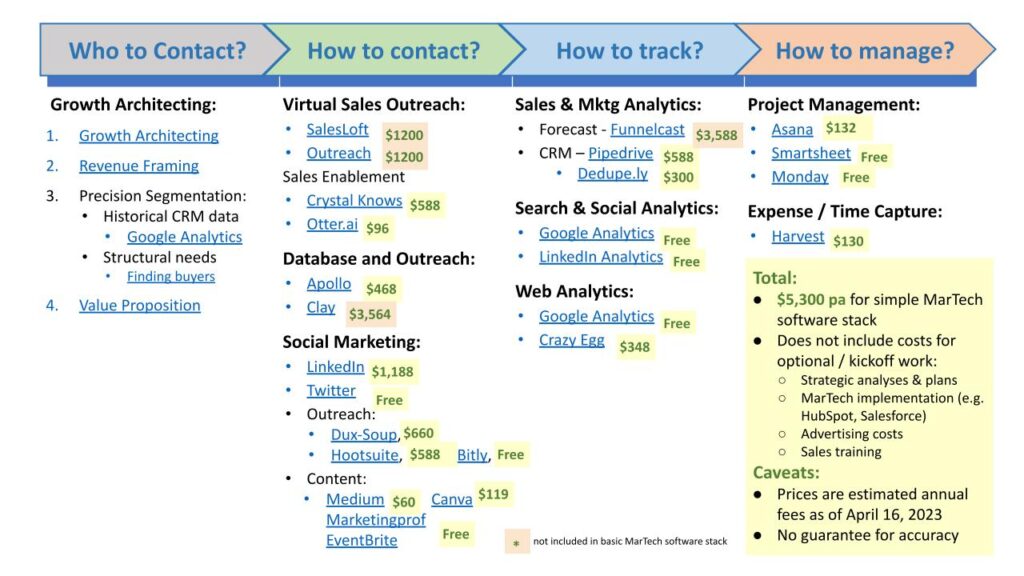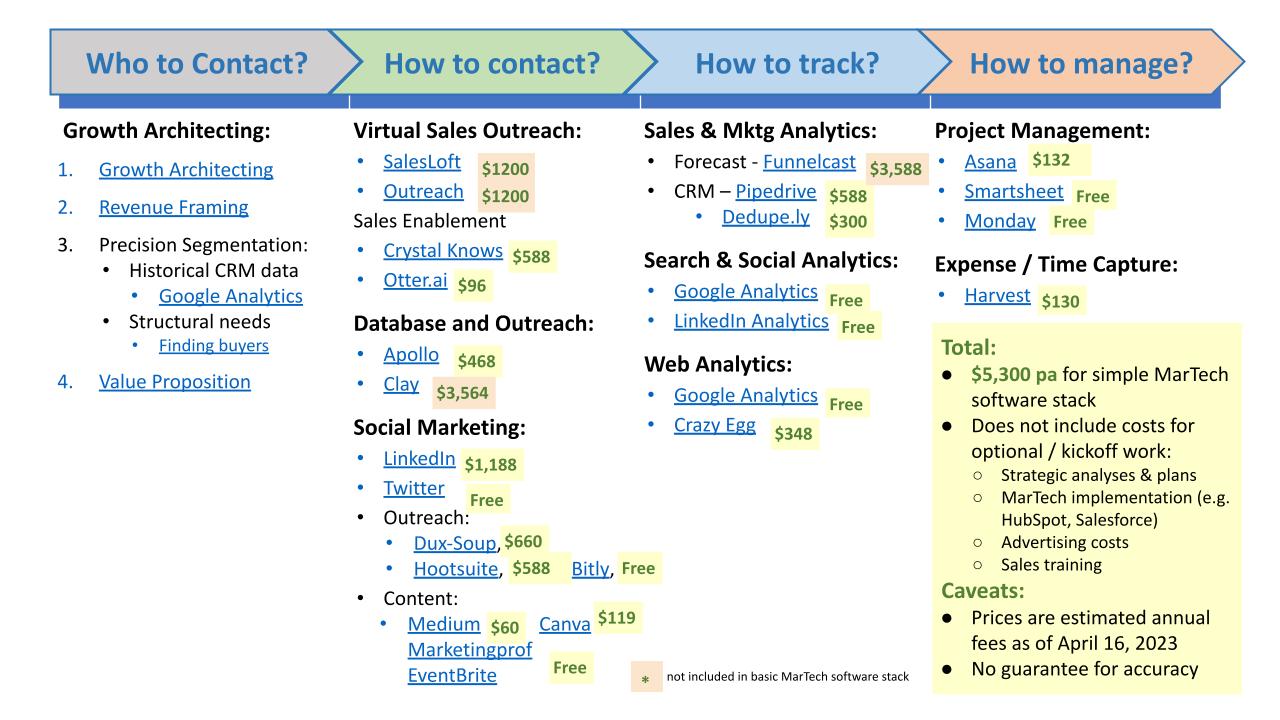More with less: Build pipeline with a $500/mo stack
What a difference a year makes: The Covid changes were followed by the 2021/22 mini-boom, which has now also been over for about a year. And with that came smaller budgets, layoffs, and uncertain market conditions. All that adds to enormous pressure on still delivering revenue growth while keeping costs low. Digitally-based outreach is one of the few remaining sources where start-ups get leads, allowing them to generate leads for a low monetary investment (assuming it’s done right; see here for more).
Overcoming these challenges in 2023 requires taking a novel approach to low-cost demand generation: We have tested and proven such an approach that can help teams do more with less. After you have read this post, you will have a reference blueprint to build a low-cost MarTech stack that gives you much of the power of a stack consisting of enterprise-grade apps like HubSpot, Marketo, and Salesforce … but literally at a fraction of the cost.
Digital selling is evolving:
Given the growing importance of digital marketing and selling for B2B companies, Gartner issued a recent report, highlighting three key themes driving CMO strategies in 2023 (link). One of their key themes is providing mutual value in digital channels throughout the full cross-channel journey. Gartner also reported that 68% of B2B buyers recently completed a recent significant purchase transaction through digital commerce (i.e., ordering and paying online), as opposed to traditional rep-led procurement.
Who to target
Fewer marketing dollars leave less room for error in the customer segments that you want to target. Tools like LinkedIn Navigator or Apollo allow precise, demo- and firmographic targeting, esp. when integrated with your CRM system through tools like Dux-Soup. And with Google Analytics you can see customers across devices and platforms, and it gives you the tools, free of charge, to understand the customer journey and improve marketing ROI.
How to target?
- Engaging: Now that sales calls, demos, and even trade shows have become virtual and will stay that way for quite some time, virtual sales meeting solutions like SalesLoft or Outreach can help you engage current and prospective customers live online while you capture leads, engage with prospects, and track event effectiveness, all in real-time.
- Connecting: With our simple, lean tech stack we can connect with decision makers within your target businesses through omni channel campaigns that combine LinkedIn ads and invites and email nurturing campaigns. Tools such as Dux-Soup that have out-of-the-box integrations with a low cost CRM tool like Pipedrive are tailored to help small businesses find and connect with very precisely targeted audiences, as well as score and track the resulting leads.
- Advertising: You can develop very targeted lead generation campaigns using tools like LinkedIn advertising and marketing, but unless your messaging and targeting are precisely worked out, this can get expensive (for more tips see here). By integrating first LinkedIn and then Google advertising campaigns, you can target and then retarget the exact right decision-makers and influencers within a business. These platforms also provide trackability that makes it simple to measure ROI.
- Posting: for posting on social media (like LinkedIn or Twitter) you can use an automatization tool like Hootsuite that helps with scheduling posts on different social media platforms and Bitly that generates tracking links that you can attach to your posts.
How to implement your $500 a month MarTech stack?
So far, we have laid out all the elements you could be using to enable digital selling and marketing and how tracking and analyzing your campaigns can optimize your pipeline. Since you might be interested in more specific information about these applications and how to make them work, we added some more details here:
- Pipedrive, Dedupely: Pipedrive is an easy to implement and integrate sales CRM and pipeline management software that will do most of what an enterprise grade CRM does at a fraction of the cost. Dedupely can then be used to track and consolidate duplicate lead entries to create a high-quality database.
- LinkedIn Navigator, Dux-Soup, LinkMatch, CrystalKnows, Otter.ai: LinkedIn is an important part of your pipeline-building tool kit. The combination of LinkedIn Sales Navigator, Dux-Soup, and LinkMatch can automate the importing of your newly generated and old network contacts into your CRM tool (here we’re using Pipedrive). Sales Navigator supports an advanced lead search, makes lead and account recommendations, and helps you stay up to date with target company news. LinkMatch allows you to instantly see which LinkedIn profiles are in your CRM and which ones are not. You can then save profiles into your CRM and synchronize your CRM whenever a profile is updated. Dux-Soup can automate connecting with these profiles with personalized messages while collecting every profile’s contact information that can be plugged into your CRM system. How can you ensure that these profiles respond to you? CrystalKnows is an AI tool that you can use to scan a person’s LinkedIn profile, assess their personality type, and make suggestions on the type of messaging that is most likely to get them interested. Your next step would be to record all your sales calls with Otter.ai. Which is a conversation intelligence platform that helps record conversations and come out with keynotes, summary or structure of the conversation. You can also send Otter.ai to a meeting instead of you. It’s very good if you have a team of a few salespeople because this tool can help you improve your sales process and help with training.
- Apollo.io, Clay.run: While the pipeline management and LinkedIn tools will ensure that the leads in your database are constantly updated, email nurturing will ensure that customers and prospects are consistently hearing from you. Apollo.io is a database with contacts and it also automates and tracks your email outreach for you. For keeping everything organized and on track you can use Clay.run that integrates with your CRM and helps you with hyper-targeted outbound, meaning it is able to with help of Chat GPT4 craft and stage mass-customized messaging at scale for us in different outreach platforms.
- Google Analytics, Outreach: Real-time and automated segmentation using tools like Google Analytics can help businesses tailor their messages and offering to meet the needs of different customer segments. Outreach is an intelligent sales workflow platform that helps you execute sales.
- Hootsuite, Bitly, Medium, Canva, Marketingprofs, Meetup: Consistent and high-quality content marketing and social media marketing is essential for pipeline building. Good content facilitates conversion by building trust with and educating your leads and customers. Medium is a social publishing platform where you can post thought leadership content that can be discovered by your target audience. You can then use Bitly to identify which platforms give you most traction. Bitly helps you brand and customize links, track real-time click data, and identify top referrers and locations for all your links. If you want to create videos or graphic posts you can use Canva, which has great features and it’s easy to use. If you want to engage with prospects and customers beyond blog posts, emails, and social media, Meetup may be a great marketing tool for you. Build groups that cater to the interests of your prospects and customers and engage them with virtual educational events. A great way to start using Meetup is to frequent other groups and see if the organizers will have you speak for five minutes about a topic in which you have expertise. To tie all of this content marketing and social media promotion together, use a social media management software like Hootsuite that helps you create, schedule, and analyze your content. If you’re looking for marketing content you can search on many different marketing topics at Marketingprof.
- Google Analytics, Crazy Egg: Now that you have a website and all this content out there, it is important to analyze the traction it is bringing you so that you can optimize your content and your promotion strategy based on real feedback. Google Analytics allows you to analyze your website performance and track audience behavior and demographics. How to make sense of all this data? Crazy Egg is a great tool for your MarTech stack that helps you visualize your Google Analytics and optimize your website through A/B testing.
- Asana, GetHarvest: Now that we have a fair bit to execute before we start generating leads through our lean MarTech stack, let’s talk about a project management tool. Asana can help your marketing and sales teams collaborate on plans, manage interdependencies and expectations, and prioritize their workflow. Keep track of the time and resources you invest in your endeavors via GetHarvest which is a time and expense tracking tool.
Here is a graphic showing how to implement this methodology using our lean, low-cost MarTech stack:









